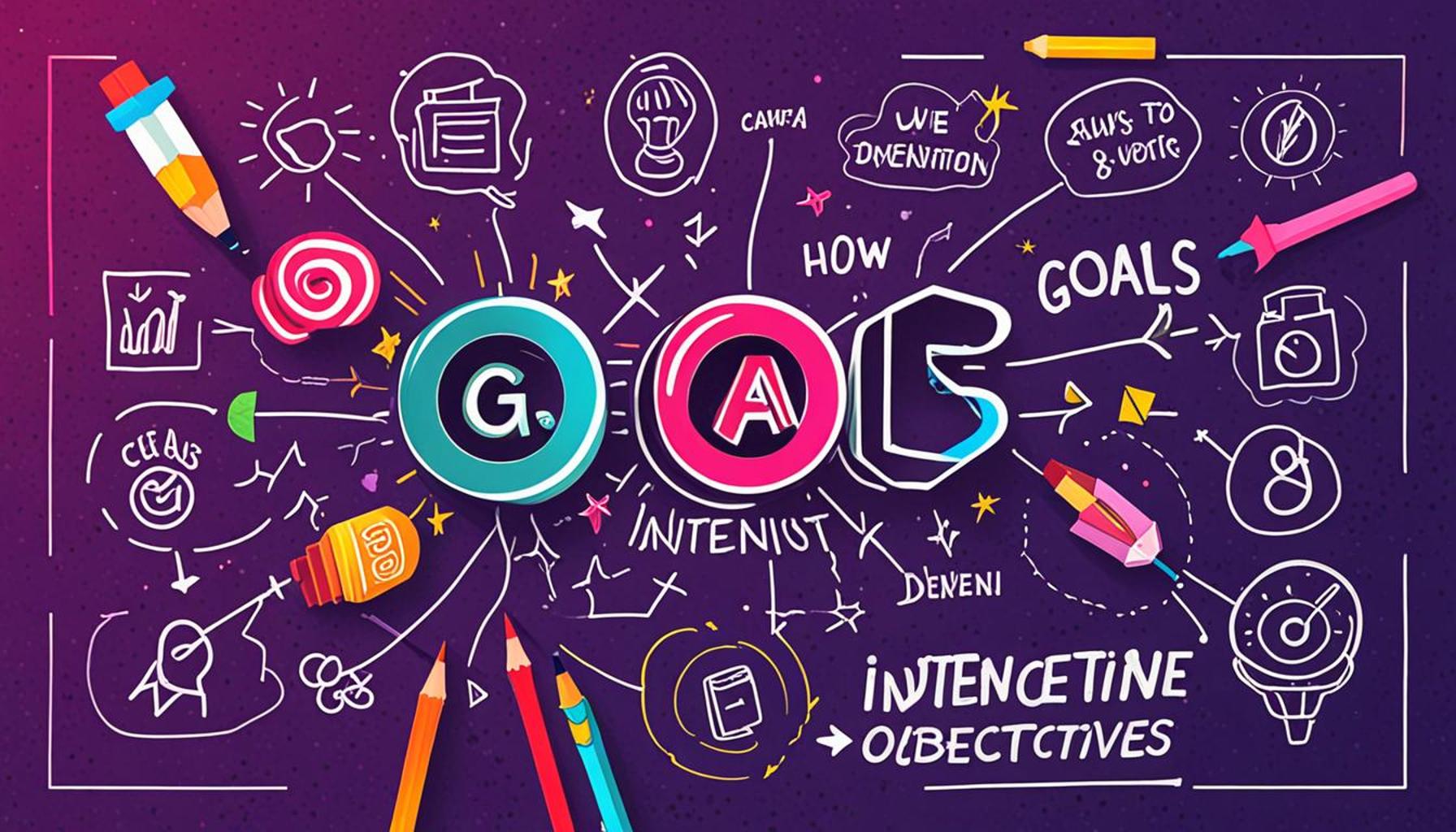How to Distinguish Goals Objectives and Intentions Effectively

The Importance of Clarity in Personal and Professional Development
In an increasingly complex world, navigating the paths to success can be overwhelming. The terms goals, objectives, and intentions are often used interchangeably, yet they possess distinct meanings and applications. Understanding their differences is crucial for anyone looking to implement effective strategies in personal or professional development.
What Sets Them Apart?
- Goals: These are broad, overarching targets that provide a sense of direction and purpose. For instance, a young entrepreneur in Nigeria may set a goal to launch a successful tech startup. This goal serves as a guiding beacon, outlining what the individual aims to achieve in the long term.
- Objectives: These are specific, measurable steps taken to achieve goals. Continuing with the startup example, the entrepreneur might establish objectives such as acquiring 100 users in the first month or securing funding from investors within the next six months. These objectives break down the larger goal into achievable milestones that allow for monitoring progress.
- Intentions: This term refers to the motivation or mindset behind actions. For the entrepreneur, the intention might be to create innovative solutions that enhance productivity. This intrinsic drive not only shapes the capacity to execute tasks but also influences how obstacles are navigated along the way.
For individuals and organizations in Nigeria, distinguishing these elements can simplify planning and enhance productivity. For instance, a student might set a goal to graduate, establish objectives like maintaining a specific GPA or completing assignments on time, and hold the intention to develop a strong work ethic. This clarity can lead to more focused study sessions and reduce procrastination.
Why This Matters
Clarity in each category leads to better decision-making and strategic planning. When individuals understand their goals, objectives, and intentions, they are better equipped to make informed choices that align with their long-term aspirations. This is particularly relevant in Nigeria’s dynamic job market, where clarity can often be the difference between merely surviving and truly thriving.
Moreover, leveraging these distinctions can drive success in various contexts, including education, career growth, and personal fulfillment. By separating long-term aspirations from the smaller steps needed to achieve them, individuals can track their progress and adapt their strategies as necessary. Additionally, reflecting on one’s intentions can help cultivate a positive mindset, which is often essential in overcoming challenges.
In conclusion, understanding the nuances of goals, objectives, and intentions is not just an academic exercise; it’s a vital component of effective personal and professional development. Join us as we delve deeper into how to apply these concepts effectively in your life, revealing practical strategies and insights that can lead to meaningful achievements.
SEE ALSO: Click here to read another article
Navigating the Landscape of Aspirations
To truly master the art of personal and professional development, one must first demystify the terms goals, objectives, and intentions. Though often used interchangeably in conversation, each word represents a unique layer of our aspirations. Understanding their roles not only helps clarify our direction but also enhances our strategic approach to achieving meaningful outcomes.
Deconstructing the Concepts
When we delve into the nuances of these terms, we uncover the framework needed for effective planning and execution:
- Goals: At the highest level, goals are the destination. They are ambitious, broader targets that provide purpose. For example, a Nigerian university graduate may have the goal of becoming a leader in the renewable energy sector. This lofty aspiration serves as the anchor that aligns all subsequent efforts.
- Objectives: Objectives form the stepping stones toward those goals. They are specific, measurable actions that outline how one intends to reach the overarching goal. In our example, the graduate might set objectives such as applying for five internships in the renewable energy field within three months or attending relevant workshops each semester. Each of these objectives breaks the larger ambition into digestible, actionable steps.
- Intentions: Intentions delve deeper into the motivation behind our actions. They are the conscious choices we make in alignment with our values and desires. In the case of our graduate, their intention might be to contribute positively to environmental sustainability and inspire others in the industry. This underlying drive fuels their commitment and resilience as they navigate the challenges of their path.
Recognizing these distinctions creates a powerful framework for action. In Nigeria, where the landscape is often complex and competitive, efficient navigation is essential. For instance, a small business owner may set a goal of expanding their local market reach. Subsequently, they could establish objectives like increasing customer engagement on social media by 50% within six months or participating in two community events per quarter. The intention supporting these actions might be to foster community connections that elevate their brand’s local presence.
Bridging Ideas and Execution
Successfully distinguishing and connecting these three components empowers individuals to create actionable roadmaps. When goals, objectives, and intentions are harmonized, the path to success becomes not only clearer but more navigable. This structured approach encourages a proactive mindset, equipping individuals to face obstacles head-on and adapt their strategies in real-time.
Additionally, incorporating these distinctions into daily routines can transform aspirations into tangible achievements. As those in Nigeria continue to pursue their dreams amidst changing circumstances, a solid understanding of goals, objectives, and intentions can help illuminate their journey. Through this lens, we not only clarify our paths but also embrace the transformative potential that lies in well-defined planning.
Understanding the Core Differences
In today’s fast-paced world, being able to distinguish between goals, objectives, and intentions is essential for personal and professional success. These three elements, while often used interchangeably, embody different aspects of planning and execution.
Goals vs. Objectives
Goals are typically broad outcomes that we strive to achieve. They are overarching aspirations that guide our actions and provide a direction. For instance, one might have a goal to improve personal health or enhance professional skills. On the other hand, objectives break these goals down into measurable and specific milestones. For example, if the goal is to improve health, an objective could be to exercise for at least 30 minutes, five times a week. By defining objectives, you can track progress and adjust your strategies to stay on course.
Intentions: The Driving Force
While goals and objectives represent the end results and the plans to reach them, intentions reflect the mindset or motivation behind pursuing these goals. Intentions act as a compass, guiding decisions and influencing behaviors. For example, one might set a goal to achieve a promotion at work. The intention behind this goal could stem from a desire for personal growth or recognition of one’s efforts. Understanding intentions can elevate your actions, ensuring they are aligned with your core values and beliefs.
The Importance of Clarity
Developing clear distinctions among goals, objectives, and intentions enables individuals to streamline their efforts, avoid confusion, and maintain focus. Given that many people juggle multiple priorities, recognizing how these three elements interact can lead to more effective time management and productivity.To exemplify how these distinctions can be practically applied, consider the process of project planning in a corporate environment. A project manager might establish a primary goal of completing a project on time. The objectives could include specific deadlines for individual milestones, while the intention may involve teamwork and collaboration to foster a positive work environment. By understanding this framework, teams can align their efforts and communicate more effectively, leading to successful project outcomes.By taking the time to distinguish between goals, objectives, and intentions, you empower yourself to navigate your aspirations deliberately and effectively. This, in turn, enhances not just personal fulfillment but overall achievement in various life domains.
| Category | Description |
|---|---|
| Goals | Broad outcomes or end results aimed at achieving success in various aspects of life. |
| Objectives | Specific, measurable steps taken to reach goals, allowing for progress tracking. |
| Intentions | Motivations or mindsets driving the pursuit of goals, which aligns actions with values. |
SEE ALSO: Click here to read another article
Integrating Strategies for Successful Outcomes
As we deepen our understanding of the distinctions between goals, objectives, and intentions, it becomes essential to explore how to effectively integrate these components into our planning processes. This integration is especially vital in a dynamic environment like Nigeria, where multiple factors can influence both personal and professional trajectories.
Creating a Cohesive Framework
To achieve success, one must develop a cohesive framework that aligns goals, objectives, and intentions with everyday actions. This approach ensures that while individuals work diligently towards their aspirations, they remain grounded in their core values and motivations. For example, a young entrepreneur in Nigeria aspiring to launch a tech startup might establish the following framework:
- Goal: Establishing a successful technology-driven business within five years.
- Objectives:
- Developing a minimum viable product (MVP) within the next year.
- Securing investment from local venture capitalists by attending at least five pitch events.
- Building a user base of 1,000 customers within the first six months of launching.
- Intentions: To promote technological innovation that improves daily life for Nigerians and empowers local communities through job creation.
This structured framework allows the entrepreneur to navigate the entrepreneurial landscape more effectively by keeping their wider ambitions rooted in actionable steps while also staying true to their underlying motivations.
Measuring Progress and Reevaluating Plans
Another crucial aspect of distinguishing between these elements is the consistent measurement of progress. Setting measurable indicators for both objectives and intentions enables individuals to track their advancement toward their goals. For instance, the same tech entrepreneur could utilize various metrics such as customer feedback scores, revenue milestones, and engagement rates on social media to assess if they are on track. In a country like Nigeria, where market dynamics are constantly shifting, being adaptive is essential. Regular evaluation fosters the ability to pivot strategies when necessary, serving as a form of resilience in the face of unforeseen challenges.
Moreover, reinforcing the connection between intentions and decision-making can lead to deeper insights and increased motivation. Personal reflection practices, such as journaling or mentorship discussions, can help maintain clarity on one’s aspirations, ensuring that actions remain aligned with fundamental values. This insight not only promotes a sense of accountability but enhances overall satisfaction and engagement with one’s journey.
Engaging with Community and Networks
Incorporating community engagement into this framework can amplify the effectiveness of our goals, objectives, and intentions. By participating in local networks, individuals can gain support and resources that propel them further along their paths. For instance, workshops, communities, or professional associations focused on technology and renewable energy can provide invaluable insights and opportunities for collaboration. Sharing experiences with peers can also foster an environment of accountability, as members collectively push each other toward success.
This communal approach is particularly relevant in Nigeria’s context, where collaborative efforts often yield better results than solitary endeavors. Individuals can harness the power of collective ambition to create positive change while simultaneously working towards personal aspirations.
The journey of distinguishing between goals, objectives, and intentions can significantly enhance one’s approach to personal and professional achievements. The intersection of conscious choice, measurable progress, and community engagement forms the bedrock for effective action, ultimately transforming dreams into reality.
SEE ALSO: Click here to read another article
Conclusion: The Power of Clarity and Direction
In conclusion, understanding the distinctions between goals, objectives, and intentions is essential for anyone looking to navigate the complexities of personal and professional development, particularly within a vibrant context like Nigeria. Effectively distinguishing these components not only enhances clarity but also fuels motivation and drives actionable steps towards success.
By establishing a coherent framework that aligns aspirations with daily actions, individuals can create a roadmap that not only follows measurable objectives but also resonates with deeper values and intentions. This method allows one to stay focused amidst Nigeria’s ever-evolving landscape, capitalizing on both individual ambition and community support.
Moreover, the journey of tracking progress and regularly reassessing strategies fosters resilience, enabling one to adapt to shifting circumstances while maintaining the integrity of their core intentions. Engaging with local networks and communities amplifies these efforts, creating synergy that benefits both personal aspirations and collective advancement.
As you delve deeper into distinguishing and integrating goals, objectives, and intentions, consider reflecting on your personal journey, both through introspection and dialogue with others. Embracing this multifaceted approach can lead to more profound outcomes—transforming dreams into reality and contributing meaningfully to the broader narrative of growth and innovation in Nigeria.


